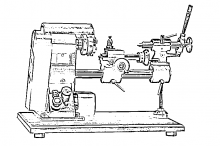RF Controlled Miniature Lathe: Spin Class
Background:
A machine lathe, often simply referred to as a lathe, is commonly used in wood and metal machine shops to create and refine small sections of materials into usable shapes, often smaller components of larger machines. Lathes contain a main rotary motor that spins the inserted material around a single axis, and with the aid of additional tools such as chisels, sanders, drills, and blades the material being worked on is processed into the form desired by the machinist. The most commonly used version of the lathe, which includes a moveable tool rest, has been in circulation since 1751, and has held a similar form since its initial use. Older versions of the lathe were often made of mostly metal, and as such were extremely cumbersome and bulky, with heavyweight lathes often weighing several tons. As technology advanced and production techniques improved, lathes slowly became capable of producing refined products similar to their predecessors while weighing much less and not taking up as much space. Eventually these smaller lathes, often referred to as “mini” lathes, were made small enough so that they could be transported anywhere, only taking up a small fraction of desk space, while also allowing for more minute adjustments and more precise and well defined outcomes. The next step in the advancement of the miniature lathe is automation; more specifically the ability to either have the lathe machine parts to predetermined shapes without any human interaction, or to aid the machine in the manufacture of small parts with the use of remote controls.
Goals and Objectives:
- Topic is well researched and problem definition is well defined (1/14)
- Design attributes are formulated and documented (1/21)
- Project design is outlined (1/28)
Objectives to be reflected in final design (3/11)
- Lathe is easy to manufacture, after main components are constructed it can be put together in an efficient manner
- Lathe is easily transportable, can fit in a backpack and sit on desktop
- The Lathe can be controlled from 5-10 feet away
- Machine will be remote controlled with use of Arduino based controller
- Lathe can process cylindrical close-celled foam
- Lathe indentation must be accurate within ± 0.25 inches
- Machine will be able to process closed cell foam without direct interaction after the foam is inserted
- Machine will meet safety standards and OSHA requirements
Innovation:
The main driving force behind this project, especially when it comes to creating a unique device, is the incorporation of the radio frequency remote control. Two motors, both tied to a transmission point on the lathe, allow for the four directional movement dictated by the signals sent from the RF controller. The radio frequency controller used for this project is the FlySky FS, a transmitter and receiver combo often used for remote control airplanes, helicopters, and cars. The dual bi-directional joysticks allow for intuitive movement control.
Machine Piece Formation Test:
In the event that the construction of the RF Controlled miniature lathe is successful, and the machine is capable of manufacturing desired shapes from the high density closed cell foam, the end test of the project would be to have the miniature lathe, with the aid of an approved project member, process a small cylindrical section of foam into the shape of a rook chess piece.
Team Contacts:
- Team Lead: Sean Coakley, scoakley@uci.edu
- Team Member: Michael Dykes, mdykes@uci.edu
- Team Member: Jacob Rider, riderj@uci.edu
- Team Member: Jianan Wang, jianaw2@uci.edu
Team Sponsor and Advisor:
- Ralph Sabbagh, rsabbag1@uci.edu

